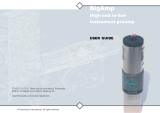
Engineers refer to this extra sound as Tizz. In contrast, a good studio ribbon mic offers the smoothest,
most accurate HF transient response you’re likely to hear. This difference in resonance structure might
explain why studio musicians universally describe the sound from our Big Ribbon
tm
mics as: “Exactly
what my ears hear when I play. It doesn’t sound like a recording.” Mark Linett observes: “What I like
best about AEA mics is their ability to handle EQ. They allow me to be creative and add almost any HF
EQ I can imagine.”
How close can you get? Quite close. These mics have a smooth extended treble response that
never sounds harsh up close. High SPL is not a big problem either. The R84 handles 165 dB SPL
>1 kHz and the A840 clips above 141 dB SPL. AEA Big Ribbons
tm
handle higher SPLs at lower
frequencies than their shorter brethren.
Proximity Bass Boost: All figure-8 mics have a proximity bass rise as the sound source gets
closer. All of us automatically pay attention to proximity effect when we first audition a mic. We
talk into it and listen for where the bass and treble balance: with lips touching the mic, out nine
inches or so, or at a distance. Compared to the R44 and A440, the R84 and A840 are balanced
for closer use. The R44’s proximity effect begins at six feet (1.8 M) and can become huge. The
RCA 44 was developed when studios were larger and mics were rarely used close up. The R84 /
A840 have a more moderate proximity effect, better suited for closer use in contemporary studios.
Different AEA mics are balanced for close (92), medium (84 & 840), and distant (44 & 840) work.
Figure-eight? These Big Ribbon
tm
mics maintains an effective figure-eight polar pattern down to 20
Hz. On stage or in the studio, such a well controlled polar pattern is very useful. A figure-eight has the
same directivity index as a cardioid and with the null area being a plane at 90 degrees to the main axis
rather than a point at 180 degrees, you now have access to a new bag of tricks.
Blumlein and More: This purist stereo technique is also useful for studio tracking. Blumlein stereo is
a pair of figure-8 mics set vertically coincident at 90 degrees to each other. Solo and ensemble micing
use the 90 degree arc between the front left axis and front right axis.
When musicians want to play face to face and track isolation is needed, this technique is a
lifesaver. Place the musicians at right angles to each other with their instruments facing the front of
one mic or the other. Track isolation between instruments is excellent as the principal axis of one mic
is the null plane for the other. Individual instruments such as guitar and bass amps can be isolated and
variations such as spaced pairs can be used to isolate entire sections, such as the saxes from the horns.
Rigging a R84 or A840 pair for Blumlein requires a boom arm and a pair of right angle mic
clamps. The Konig & Meyer model 238 clamps on a K&M 211/1 adjustable boom work well. The
telescopic boom makes it easy to adjust the distance between the R84 end caps until they are almost
touching. A small foam rubber pad can be used between the top end caps if a desired. Setting up a
Blumlein pair of R84s does take time, which is why we offer the AEA R88 Blumlein ribbon mic.
“This Side” and “That Side” The sound of your R84 / A840 is slightly different between the front
and the back — subtle, but sufficient to offer two “flavors.” In addition to polarity, this is caused by
using two wraps of grill cloth on the back and only one on the front. So, don’t think in terms of front
and rear, think “This Side” and “That Side.” If your pre-amp or console has the option, try using the
phase (polarity) switch when on the back side of the R84. Voices and horns put more energy into the
positive than the negative half of each wave, so it is useful to be able to switch polarity.














